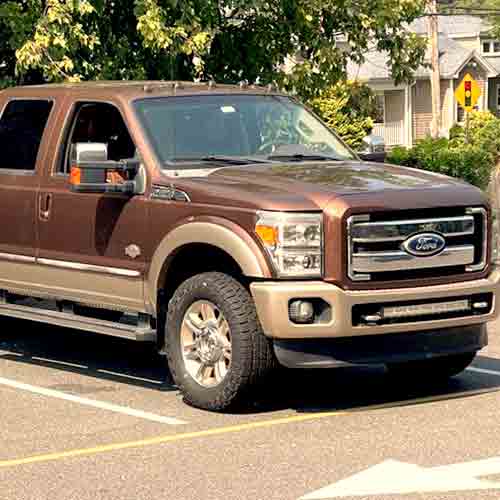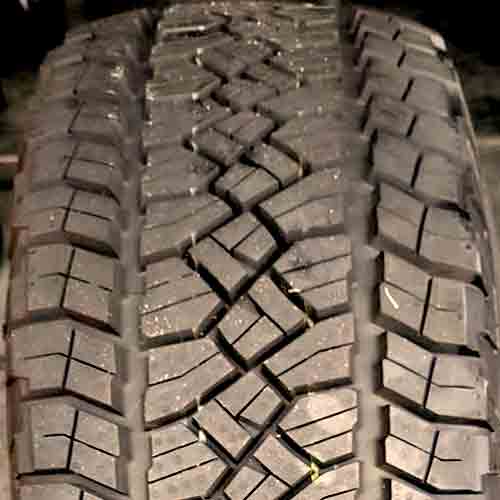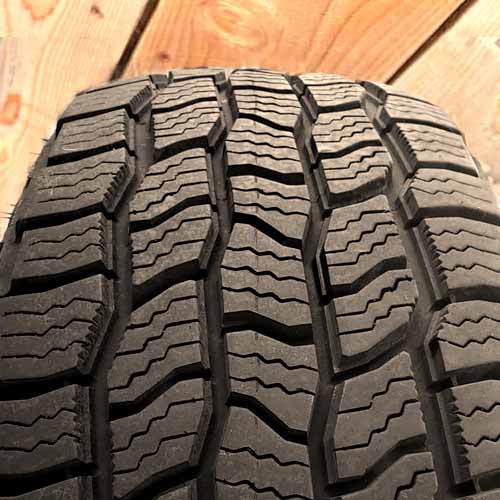Both the General Grabber APT and the Cooper Discoverer AT3 4S are great at what they can do, considering they are all-terrains. These tires show that the overall market has made some serious progression over the years. Though which one is a better pick for you? Let’s find out!

In my expert opinion as a tire engineer, the Cooper AT3 features a better traction on dry and wet roads. And it’s fuel economy and tread life is also really appreciative here. On the other side, although the General Grabber APT does okay on dry roads, it really lacks behind on wet, though its winter performance is not so bad, and its off-road traction is better in comparison.
Tire Facts
The Cooper Discoverer AT3 4S (review), comes with 42 total sizes in 15″ to 22″ rims. These sizes have following specs.
- Load range: SL and XL
- Speed ratings: T and H
- Weight range: 31 to 45 lbs
- Tread depth range: 12.5 to 14/32″
- All sizes have 3PMSF ratings
- Warranty: 65k miles
On the other side, the General Grabber APT (review) gives you 16 to 22 inches rims, with sizes having following specs.
- Speed ratings: R, S, T and H (H is only on one size).
- Load ratings: SL, XL, C and E.
- Weight range: 28 to 58 lbs.
- Tread depth: 13 to 16/32″.
- Ratings: 3PMSF and M+S.
- Warranty: 60k miles.
Tread Design
Starting with Grabber APT, the tire features a very prominent divided central section (from the outer shoulder ribs).

Starting from the middle…
The symmetric tread pattern consists of 3 ribs here, with blocks arranged in both lateral and longitudinal fashion.
This way they create an interlocking web of grooves connecting all parts of the tread, providing the tire with self cleaning capabilities.
Moreover, these lugs also have a lot of biters combined with foundations underneath, so they deliver traction and stability on smooth pavements as well.
The shoulder lugs are slanted, have off-set edges and thick longitudinal slits on them and where both of these provide lateral grip, the outer staggered edges provide the needed off-road traction.
Though I really miss the sidewall lugs on this tire. As it could have done wonders for it off-road.
The Cooper Discoverer AT3 XLT, on the other hand, comes with a more aggressive structure.

It’s sidewall lugs are chunkier and when you air down the tire, they supply you with an extra tread print, needed for crawling traction (especially on rocky and sandy terrains).
Moreover, they also get to be joined with the shoulder lugs, and these combined with ridges placement in between their lateral grooves, offer lateral stability.
Moving towards the middle part of the tread, here 3 longitudinal ribs are seen with similar features, of interlocking sipes, foundational supports and in-groove biters.
And just like the shoulder lugs, the blocks in the outer ribs, have snow vices in them (I’ll explain that in the winter performance section).
Note: The sidewall lugs are the main features which differentiates the Cooper AT3 XLT, from the Discoverer LT and the Discoverer 4S, (the other variants of this tire, before it only used to be under just one “Cooper AT3”).
Tire’s Toughness
Durability is a crucial aspect for off-road tires which have to perform effectively in rough conditions with proper resistance to punctures. To meet this requirement, most of them have cut-resistant rubbers and deep tread voids. Though that’s only 20% of the tire’s durability, the rest comes form the internal construction.
Having said that, although both tires, give you 2 ply polyester casing, and 2 wide steel belts on top, the overall toughness is still offered better on Cooper Discoverer AT3, even though here you get a single nylon cap ply. So why is that?
Well, because the most vulnerable part of the tire is sidewalls, and protecting them are Cooper AT3’s bulkier lugs, whereas you don’t see any on General Grabber APT.
Off Road Efficacy
Though they are on-road oriented, daily driving all-terrain tires, I thought it would be best to discuss their off-road performance before getting on their highway capabilities.
I tested both of these tires on the following terrains. out in the following terrains.
On Rocks
The perfect tire for driving on rocky terrains should have ample biters to grip in all directions.
And Grabber APT with interlocking structure in the middle provide exactly that. Its full depth siping and notches split open it’s lugs, and they flex towards multiple angles providing a better mixture of lateral and longitudinal traction.
The Cooper AT3 on the other side, lacks with it’s squared off block structure, lacking with biters. Though it’s XLT variant is pretty good here, as at-least that one get to have sidewall lugs which with lowered air pressure provide superior grabbing capabilities on rocky terrains.
Muddy Tracks
The ability of all-terrain tires to perform well in mud is largely determined by its tread voids.
That’s why both tires, with narrow grooves result in mud packing and cannot provide a decent traction values. Though still on lighter terrains, you see a better grip with Cooper AT3.
This is mostly because of it’s staggered shoulders, acting as mud scoops, throwing thick clay backwards, and moving forward with the resulting force.
General Grabber APT on the other side, not only is missing with these “scoops”, but the tire’s inter-linking (groove) structure in the middle is very inviting to mud particles. So it lacks overall.
Soft Sand
A “good enough” tire on sand must have sidewall lugs, smoother outer edges, lighter weight, and paddling abilities.
And so considering both tires, I have to go with Cooper AT3 on this one, the tire features smoother outer edges comparatively, has a lighter construction, and with mud scoops on it’s staggered shoulders it provides better paddling abilities.
General Grabber APT on the other side, has a harder compound, which is more prone to digging.
Highway Performance
The dry performance of an all-terrain tire is a critical factor that can be evaluated through its traction, steering, and cornering abilities. Let’s take a closer look at these key components.
Dry Grip
The friction of a tire on dry roads is expressed as dry grip (or directional grip while moving straight, which gets evaluated through analyses of braking distance and acceleration time).
That’s why with better longitudinal orientation of the lugs, and lighter structural weight (on average), the Cooper AT3 4s shows better highway performance.
The vertically aligned lugs provide better connection of the lugs with the road (while moving directionally), while with lighter weight, the tire does not form as much of a moving inertia, as its counterpart.
The General Grabber APT on the flip side, lacks because of it’s irregular connection with the road, as lugs have (greater) lateral tread voids, though the difference is only marginal, and its harder compound keeps lugs stable, which brings us to the next sub topic.
Handling on Dry
The tire’s lateral traction during cornering is linked to the contact between the ground and the outer shoulder lugs, as the weight shifts towards there.
And so it makes sense why the Cooper AT3 4S shows superior results here as well. The tire has greater footprint offering towards the shoulders, it features shallower tread depth, and it’s weight is overall lighter in comparison.
With greater contact patch, it creates more rolling friction (as the tire turns), and with less deep tread voids, combined with lighter structure, it’s lugs don’t want to flex too much, allowing the tire to have a faster steering response.
The General Grabber APT on the other side has wider lateral grooves, and it’s lugs bend more with greater tread depth.
Wet Grip
The General Grabber APT really lacks on wet roads. This has to do with the tire’s inability to clear water at a micro level (quickly). Let me explain.
On watery roads, most of the water gets channeled out through the tread voids, and being bald enough, both tires supply ample of that, and with it, resistance to hydroplaning.
But with a stiffer composition, and rectilinear structure of sipes, the General Grabber APT is not able to clear the left-over water (that wasn’t cleared off with the grooves).
Here sipes have to work, and they suck these water particles in their slits. Though with a more rigid compound, the Grabber APT does not yield enough suction abilities to them, and so they can’t wipe off as much water as it’s competitor.
Cooper Discoverer AT3 4S on the other side, has a wave like siping structure, and they are better able to squeeze even under pressure (when a tire suddenly brakes or corners). Moreover it’s tread is also a lot more softer, so the sipes already have more flexibility to them, to begin with.
So overall you see a better wet performance on Cooper’s boy.
Fuel Efficiency
Out of both tires, the Cooper AT3 is a more fuel efficient tire. This is simply because of two main things.
- The tire has a lighter structure, so less energy is required to move its weight.
- And its lugs are more packed up together, meaning each lug carries less distributed weight on them, and so because of that they rub off the surface (they are on), with less pressure.
The Grabber APT on the other side, being slightly more aggressive, having more tread voids, gets to put more pressure on it’s lugs, causing them to produce greater rolling resistance and with it fuel consumption.
Moreover, as it’s lugs are also not well supported, their flexing also cause them to wear faster comparatively. Though the difference is very low, that’s why you only get 5k more miles on Cooper AT3 4S.
Increase tread life: https://tiredriver.com/how-to-increase-tread-life-on-tires/
Winter Performance
Both tires are although 3 peak mountain snowflake rated, they show up with mixed results. Let me explain, but first, you need to understand the following.
For winter performance, off-road tires, try to hold on to snow particles and make contact with them (on the ground). This is because snowflakes have an intermingling structure, and they stick on snow more compared to the tire’s rubber.
That’s why the General Grabber APT with it’s interlocking structure in the middle hold on to the snow better there, and provides superior braking efficiency and acceleration values.
Whereas with snow vices on the outer longitudinal grooves, and in groove-notches on shoulders, the Cooper Discoverer AT3 4S yields better handling results.
So which tire takes the upper hand here? Well, overall, Cooper is up for the win. This is because with staggered shoulders, the tire can take on deeper terrains in a better way as well, along with it’s handling capabilities.
And it’s softer (in comparison), compound is less susceptible to get as stiff with freezing temperatures, as the Grabber.
If you prefer snow traction a lot more, you may want to check out my guide on all-terrain tires on snow performance.
Ride Quality
The comfort level of a ride is impacted by two defining factors – the tire tread noise and the tire’s ability to absorb road imperfections through its structure and tread composition.
And the Cooper Discoverer AT3 4s is better in both departments. The tire’s softer compound with greater tread depth, dissipate road shocks and vibrations in a better way, providing smoother driving experience.
And with closed up shoulder lugs with ridges in between, it doesn’t allow air particles to come in (with full force) and strike the walls of the tread, generating noise. So it also yields a quieter ride comparatively.
The General Grabber APT on the other side, although features greater tread depth, or should I say thicker rubber between you and the bumps, it’s stiffer compound is still not able to cushion bumps as much as its counterpart.
Though deeper tread voids, do provide a larger area for the air particles to collide around, and so it’s tread gets to be louder, though the difference in marginal overall. Meaning, in terms of noise, you won’t be disappointed with either one of these boys.
Summing Up
So overall, the Cooper AT3 is a better pick for pavements, roads, and highways, both in wet and dry environments. This is because it provides better traction (grip), steering response, fuel economy and tread life.
The General Grabber APT although is good enough on dry, really lacks on wet roads, but it’s a better tire for off-road use, in nearly all types of (mild) off-road terrains.